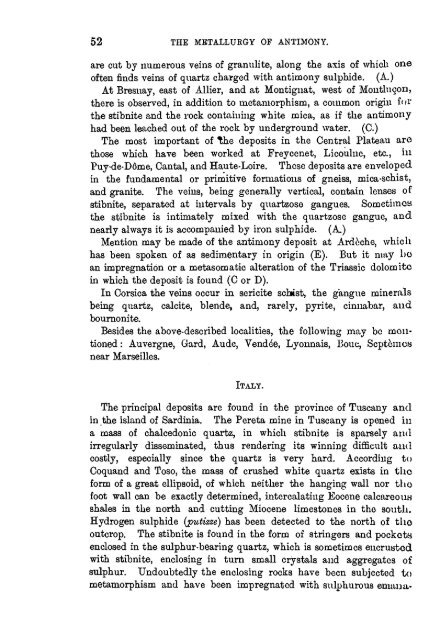antimony - Sciencemadness.org
antimony - Sciencemadness.org
antimony - Sciencemadness.org
You also want an ePaper? Increase the reach of your titles
YUMPU automatically turns print PDFs into web optimized ePapers that Google loves.
52 THE METALLURGY OF ANTIMONY.<br />
are cut by numerous veins of granulite, along the axis of which one<br />
often finds veins of quartz charged with <strong>antimony</strong> sulphide. (A.)<br />
At Bresnay, east of Allier, and at Montignat, west of Montlugon,<br />
there is observed, in addition to metamorphism, a common origin fox*<br />
the stibnite and the rock containing white mica, as if the <strong>antimony</strong><br />
had been leached out of the rock by underground water. (C.)<br />
The most important of the deposits in the Central Plateau are<br />
those which have been worked at Freycenet, Licoulne, etc., in<br />
Puy-de-D6me, Cantal, and Haute-Loire. These deposits are enveloped<br />
in the fundamental or primitive formations of gneiss, mica-schist,<br />
and granite. The veins, being generally vertical, contain lenses of<br />
stibnite, separated at intervals by quartzose gangues. Sometimes<br />
the stibnite is intimately mixed with the quartzose gangue, and<br />
nearly always it is accompanied by iron sulphide. (A.)<br />
Mention may be made of the <strong>antimony</strong> deposit at Ardeche, which<br />
has been spoken of as sedimentary in origin (E). But it may be<br />
an impregnation or a metasomatic alteration of the Triassic dolomite<br />
in which the deposit is found (C or D).<br />
In Corsica the veins occur in sericite schist, the gangue minerals<br />
being quartz, calcite, blende, and, rarely, pyrite, cinnabar, and<br />
bournonite.<br />
Besides the above-described localities, the following may be mentioned:<br />
Auvergne, Gard, Aude, Vende'e, Lyonnais, Bouc, Sopt6nic»<br />
near Marseilles.<br />
ITALY.<br />
The principal deposits are found in the province of Tuscany and<br />
in the island of Sardinia. The Pereta mine in Tuscany is opened in<br />
a mass of chalcedonic quartz, in which stibnite is sparsely and<br />
irregularly disseminated, thus rendering its winning difficult and<br />
costly, especially since the quartz is very hard. According to<br />
Coquand and Toso, the mass of crushed white quartz exists in tho<br />
form of a great ellipsoid, of which neither the hanging wall nor tho<br />
foot wall can be exactly determined, intercalating Eocene calcareous<br />
shales in the north and cutting Miocene limestones in the south.<br />
Hydrogen sulphide (jputizze) has been detected to the north of tho<br />
outcrop. The stibnite is found in the form of stringers and pockets<br />
enclosed in the sulphur-bearing quartz, which is sometimes encrusted<br />
with stibnite, enclosing in turn small crystals and aggregates of<br />
sulphur. Undoubtedly the enclosing rocks have been subjected to<br />
metamorphism and have been impregnated with sulphurous emana-
















